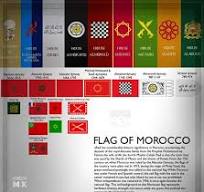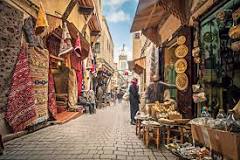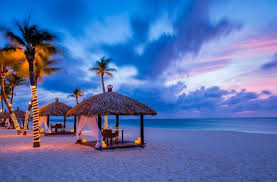The History of the Moroccan Flag
The flag of Morocco, known as the “Flag of the Green March,” is a symbol steeped in history and significance. Its design and colours reflect the rich heritage and identity of this North African nation.
Early Origins
The first version of the Moroccan flag dates back to the 11th century during the reign of the Almoravid dynasty. It featured a simple black background with a white circle in the centre. Over the centuries, various dynasties and rulers introduced their own versions of the flag, incorporating different symbols and colours.
The Modern Flag
The current flag of Morocco was officially adopted on November 17, 1915. It consists of a vivid red background with a green pentagram in the centre. The red colour represents bravery and valour, while green symbolises hope, joy, and love in Moroccan culture.
Symbolism
The pentagram on the Moroccan flag holds deep symbolism for the country. Each point of the star represents one of five pillars: God, homeland, king, people, and constitution. This emblematic design embodies unity, faith, and national pride among Moroccans.
Historical Significance
Throughout Morocco’s history, its flag has been a powerful symbol of independence and sovereignty. During periods of colonial rule and foreign occupation, Moroccans rallied around their flag as a beacon of resistance and unity.
Celebrations
Every year on November 18th, Moroccans celebrate Flag Day to honour their national emblem. The day is marked with parades, ceremonies, and patriotic displays that showcase the enduring significance of the Moroccan flag in shaping the country’s identity.
Conclusion
The Moroccan flag stands as a proud symbol of resilience, unity, and national pride for its people. Its vibrant colours and meaningful design reflect centuries of history and tradition that continue to resonate with Moroccans across generations.
Unveiling the Moroccan Flag: Symbols, Stories, and Historical Significance
- What symbol represents Morocco?
- What is the 6 pointed star on the Morocco flag?
- What is the story behind the Morocco flag?
- What is the star of David in Morocco?
- Why does Morocco have the Star of David on its flag?
- Why is the Seal of Solomon on the Moroccan flag?
What symbol represents Morocco?
One of the most iconic symbols representing Morocco is the pentagram featured on the Moroccan flag. This five-pointed star holds significant meaning in Moroccan culture, with each point symbolising one of the country’s core pillars: God, homeland, king, people, and constitution. The pentagram serves as a powerful emblem of unity, faith, and national identity for Moroccans, embodying the values and principles that have shaped the nation’s history and heritage.
What is the 6 pointed star on the Morocco flag?
The six-pointed star on the Moroccan flag holds significant symbolism representing the five pillars of Islam along with a nod to the Seal of Solomon. Each point of the star symbolizes one of the fundamental tenets of Islam: faith in one God, prayer, charity, fasting, and pilgrimage. Additionally, the hexagram shape is historically associated with wisdom and unity. In Morocco’s context, this emblem on the flag embodies national unity, faith, and loyalty to both religious principles and the country’s heritage.
What is the story behind the Morocco flag?
The story behind the Morocco flag is a tale of heritage, symbolism, and national pride. The flag of Morocco, known as the “Flag of the Green March,” has a rich history that dates back centuries. Its design, featuring a red background with a green pentagram in the centre, holds deep significance for Moroccans. The red colour symbolises bravery and valour, while green represents hope, joy, and love. The pentagram on the flag embodies unity and faith, with each point representing key pillars of Moroccan society. Through periods of colonial rule and foreign occupation, the Moroccan flag has served as a powerful symbol of independence and sovereignty, rallying the nation together in times of struggle. Today, the flag continues to be a source of pride and identity for Moroccans, reflecting their enduring spirit and cultural heritage.
What is the star of David in Morocco?
The star on the Moroccan flag is not the Star of David, but rather a pentagram with five points. This green pentagram holds significant symbolism in Moroccan culture, representing the pillars of God, homeland, king, people, and constitution. Each point of the star carries deep meaning and reflects the values of unity, faith, and national pride in Morocco. The star on the Moroccan flag is a unique emblem that has been a symbol of independence and sovereignty for the country throughout its history.
Why does Morocco have the Star of David on its flag?
The presence of a pentagram on the Moroccan flag, often mistaken for the Star of David, holds significant cultural and historical symbolism. The green pentagram, with its five points, represents the five pillars of Islam: God, homeland, king, people, and constitution. This emblematic design is a reflection of Morocco’s Islamic identity and values, rather than a representation of the Star of David. It is important to understand the context and meaning behind the symbols on the Moroccan flag to appreciate their true significance in the country’s rich history and heritage.
Why is the Seal of Solomon on the Moroccan flag?
The Seal of Solomon, represented by the green pentagram on the Moroccan flag, holds significant historical and cultural importance in Morocco. The emblem is not directly linked to the biblical figure of King Solomon but rather symbolizes wisdom, unity, and protection. In Moroccan tradition, the pentagram represents the five pillars of Islam: God, homeland, king, people, and constitution. This symbol embodies the core values and principles that are integral to Moroccan identity and heritage. The presence of the Seal of Solomon on the Moroccan flag reflects a deep-rooted connection to tradition and symbolism that has endured throughout Morocco’s history.




